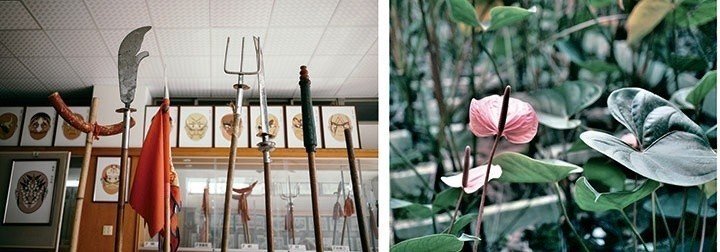The geography of Kaohsiung's Neimen District has profoundly influenced the customs and livelihoods of its residents. Covering 95.6km2, Neimen is dominated by precipitous landscapes, and a small part of the area is a basin. The terrain is rather dramatic. Neimen is adjacent to Tianliao District's Moon World badlands, and the latter's strange mudstone hillocks stretch into Neimen. Surrounded by mountains, Neimen's geography is best appreciated at the 308 Highland, so called because it is 308m above sea level. The barrenness of the badlands is one reason why Neimen folk of yore created the Neimen Songjiang Battle Array, a valuable example of intangible culture. Unable to prosper by farming due to the impoverished terrain, in the old days the Neimen area also suffered a lot of crime. To protect themselves, villagers assembled in groups and practiced various martial arts. These evolved into the Neimen Songjiang Battle Array. Neimen's early settlers crossed the Taiwan Strait from the Chinese mainland, and brought with them a belief in Guanyin, the Buddhist bodhisattva of compassion. Even today, worship of Guanyin is the most popular religion in the district. Three major temples – Neimen Zihjhu Taoist Temple, Nanhai Zihjhu Taoist Temple and Shunsian Taoist Temple – all are sites where Guanyin is worshiped. In recent years, these three temples have taken turns hosting the annual Neimen Songjiang Battle Array. This year, the grand event is being held by Neimen Zihjhu Taoist Temple, and is taking place from March 24 to April 8. The battle array has changed in recent decades. Neimen residents no longer need to defend themselves against bandits, and they now participate out of religious enthusiasm. The battle array is an expression of their devotion to Guanyin around the time of her birthday, which is observed on the 19th day of the second month on the traditional lunar calendar (in 2018 this falls on April 4). The Songjiang Battle Array incorporates sophisticated martial arts inspired by a classic Chinese novel of heroism and morality titled The Water Margin, sometimes known as All Men Are Brothers. Those not well versed in Neimen culture may be surprised by the strength of local commitment to Guanyin Birthday Festival. Despite its small population, the district sustains no fewer than 54 Songjiang troupes. Nowhere in Taiwan is there a greater density of active battle array groups. Around the time of Guanyin's birthday, many Neimen natives who live and work elsewhere return to their home villages so they can take part.  Another highlight of Neimen's Guanyin birthday celebrations is the the Guanyin Pilgrimage. Worshipers carry a Guanyin statuette on a palanquin, accompanied by ten troupes, and visit every community in Neimen District. Some communities are hidden in the steep terrain; the worshipers are undaunted, however, even when walking 30 to 40km every day. Local residents await the pilgrimage on both sides of the road, burning incense and offering feasts. The Guanyin birthday festivities demonstrate how religious events can unite people and enliven local culture. ※ Neimen's Catering Chefs Near Neimen Zihjhu Taoist Temple, one can see many storefronts which advertise the services of catering chefs. Because they lacked other economic opportunities, an impressive number of Neimen residents entered the catering industry. During the heyday of "bando" banqueting culture, one in five Neimen households was headed by a catering chef. Neimen earned a reputation as the "home of master catering chefs." The area's vibrant religious life bolstered both the catering industry (many temple events are accompanied by banquets) and performance arts designed to entertain deities. Among the latter are Taiwanese opera and Taiwanese glove puppetry. Neimen residents customarily celebrate special occasions like weddings by holding banquets. The feasts are often held in temple courtyards, and feature much-anticipated delicacies such as braised pork shank, glutinous rice with mushrooms, or Buddha's Delight (various ingredients stewed in a pot). ※ Sightseeing in Neimen Legend has it that, one night, seven shooting stars fell into Neimen's Guanting Village, and villagers found the shooting stars had left behind seven small mounds. These scattered stars resembled the Big Dipper. The residents made the mounds more elaborate and they became a symbol of the area. To preserve them, residents built towers on each of the seven original sites. The most famous Neimen native in history is Mr. Jhu Yi-guei, often called "the duck king" because he was a duck farmer who could make a flock of ducks walk in accordance with his orders. In 1721, he led a rebellion against the Cing Dynasty authorities, and sought to restore the previous Ming Dynasty. For a short period, his army controlled Tainan, then Taiwan's capital. However, due to infighting the uprising collapsed, and he was eventually executed by the Cing authorities. Neimen's Singan Temple is one of very few places in Taiwan that pays respect to Jhu, and it has established a Jhu Yi-guei memorial park. For travelers eager to see the spectacular mudstone badlands, 308 Highland offers unobstructed views. It is sometimes possible to see as far as the coast at Tainan. According to regular visitors, both sunrises and sunsets there are gorgeous. ※ The Flourishing Flamingo Lily Industry Around 40 hectares of land around Neimen are given over to the cultivation of flamingo lilies, making it a leading flower-growing district in Taiwan. Growing good flamingo lilies requires environmental and temperature control. True Beauty Garden's beautiful flamingo lilies are popular in Taiwan and abroad; some are exported to Japan for Ikebana flower arranging. True Beauty Garden is open for group tours if reservations are made in advance. Among the more than 40 types of flamingo lilies are purple, pink, white, and red variants. The Neimen Songjiang Battle Array is a fascinating sight, full of quick movements backed by drumming. The array resonates with audiences because it is an activity practiced by many Neimen residents and taught in local schools. This cultural asset is greatly cherished by Neimen folk. Deeply embedded in everyday life, it sparks endless energy. | 

沒有留言:
張貼留言